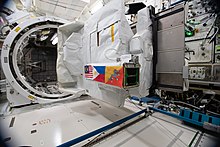
A small satellite, miniaturized satellite, or smallsat is a satellite of low mass and size, usually under 1,200 kg (2,600 lb). While all such satellites can be referred to as "small", different classifications are used to categorize them based on mass. Satellites can be built small to reduce the large economic cost of launch vehicles and the costs associated with construction. Miniature satellites, especially in large numbers, may be more useful than fewer, larger ones for some purposes – for example, gathering of scientific data and radio relay. Technical challenges in the construction of small satellites may include the lack of sufficient power storage or of room for a propulsion system.

The Philippine Atmospheric, Geophysical and Astronomical Services Administration is the National Meteorological and Hydrological Services (NMHS) agency of the Philippines mandated to provide protection against natural calamities and to ensure the safety, well-being and economic security of all the people, and for the promotion of national progress by undertaking scientific and technological services in meteorology, hydrology, climatology, astronomy and other geophysical sciences. Created on December 8, 1972, by reorganizing the Weather Bureau, PAGASA now serves as one of the Scientific and Technological Services Institutes of the Department of Science and Technology.

ABS-3, formerly ABS-5, was initially named Agila 2 after the Philippine eagle, before being acquired by ABS. Launched in 1997, the satellite provided telecommunications services for Mabuhay Satellite Corporation before being sold to ABS in 2009. Built by Space Systems/Loral, the satellite provided coverage in the Asia-Pacific region. Its control station is located at the Subic Bay Freeport Zone in the Philippines. The satellite was launched by Long March 3B and positioned at 146°E longitude.

Philippines–Russia relations are the bilateral relations between Russia and the Philippines. Both countries are full members of APEC.

Mabuhay Satellite Corporation (MSC) was a Filipino aerospace corporation responsible for operating communication satellites and before 2009, the only Philippine company to do so. It was later renamed as Mabuhay Investment Corporation (MIC) and became a holding company owned by PLDT. It once owned the Agila 2 satellite which provides coverage in the Asia-Pacific region. Aside from satellite operation, it also provided satellite-related services. It operated two space centers, namely the Mabuhaysat Subic Space Center, its main hub, and the Mabuhaysat Zamboanga Space Center at Zamboanga City, its back-up hub.

The Philippine Space Agency (PhilSA) is the national space agency of the Philippines.

Diwata-1 also known as PHL-Microsat-1 was a Philippine microsatellite launched to the International Space Station (ISS) on March 23, 2016, and was deployed into orbit from the ISS on April 27, 2016. It was the first Philippine microsatellite and the first satellite built and designed by Filipinos. It was followed by Diwata-2, launched in 2018.
Agila-1 or Mabuhay was launched on March 20, 1987, under the name Palapa B2-P in Cape Canaveral Air Force Station. It was originally under Indonesian company, PT Pasifik Satelit Nusantara until it was acquired by Philippine company, Mabuhay Satellite Corporation which is under PLDT in 1996. Upon its acquisition by Mabuhay, it became the first Philippine satellite through acquisition while in orbit. Palapa B2-P was later renamed to "Agila-1", the local name for the Philippine eagle. The satellite's operation ended in January 1998 and was deorbited.

The Philippine Earth Data Resource and Observation Center, also known as the PEDRO Center is an organization tasked in operating satellite ground stations.

Diwata-2 or Diwata-2B is a Philippine microsatellite launched on October 29, 2018. It is the first satellite launched under the STAMINA4Space program.

The Philippine Scientific Earth Observation Microsatellite (PHL-Microsat) was a satellite program carried by the Department of Science and Technology (DOST) of the Philippines in cooperation with the Tohoku and Hokkaido Universities of Japan.

Maya-1 was a Filipino nanosatellite. It was developed under the Philippine Scientific Earth Observation Microsatellite program (PHL-Microsat) and was jointly implemented by the University of the Philippines and the Department of Science and Technology as part of the Kyushu Institute of Technology-led multinational second Joint Global Multi-nations Birds Satellite (Birds-2). Maya-1 was the first nanosatellite of the Philippines.
The Space Technology and Applications Mastery, Innovation and Advancement is a space technology program by the Philippine government. It is considered as the successor program to the Philippine Scientific Earth Observation Microsatellite (PHL-Microsat) program, a cooperation between the Philippine government and Japanese universities to develop microsatellites. The program is funded under the Department of Science and Technology.

Joel Joseph Sacro Marciano Jr. is a Filipino engineer, academic and the first and current Director General of the Philippine Space Agency, a government agency under the Office of the President in charge of the Philippines' national space program.
Maya-2 was a Filipino nanosatellite. It succeeded Maya-1, the first Filipino nanosatellite, which was deorbited in November 2020.
The Multispectral Unit for Land Assessment (MULA) is a planned Filipino satellite. Upon completion it will become the largest Filipino-made satellite.
The Subic Bay Space Center (SCC) also known as the Subic Bay Teleport is a ground station at the Subic Bay Free Port in Morong, Bataan, Philippines. It is currently operated by ABS.

TALA is a hybrid-propellant rocket which is the first of its kind to be developed in the Philippines.
Gay Jane P. Perez is a Filipino physicist and environmental scientist whose research involves satellite observation of environmental conditions, and the applications of that data in agricultural planning. She is a professor in the Institute of Environmental Science and Meteorology at the University of the Philippines Diliman, and Deputy Director General of the Philippine Space Agency.
































